Contents
The Golden Rain tomato belongs to mid-season and high-yielding varieties, which are grown both in greenhouse conditions and in open ground. Among gardeners, tomatoes are known for their decorative fruits with high palatability.
Detailed description of the variety
Golden rain tomatoes are of the indeterminate type: they can reach up to 1,8 m in height. When cultivating the variety in open ground, the bush grows up to 1,5 m. The main stem is powerful, but bends under the weight of the fruit, so the construction of supporting structures is mandatory.
The leaf plates are medium in size, distinguished by a bright green tint. The tomato variety needs to be formed and pinched: no more than 4 stems are left during the procedure. The inflorescence is simple.
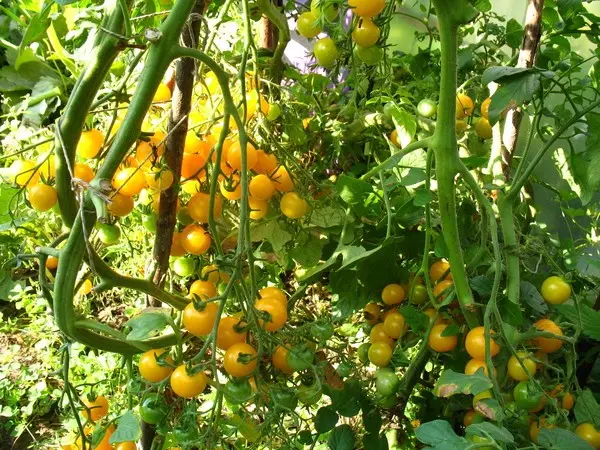
Description of fruits
The golden rain tomato bush has complex brushes, on which from 6 to 8 fruits are formed, similar in shape to a pear. Tomatoes are green in color, as they ripen, they change color to light yellow.
According to the description and reviews, the Golden Rain tomato variety has a very rich taste: sweetish, with a slight sourness and a pronounced smell. The photo allows you to evaluate the tomatoes in the context: the seed chambers are separated by a dense partition, the flesh inside is very fleshy and juicy.
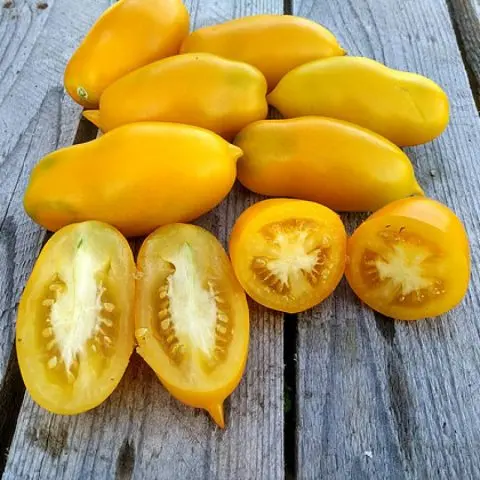
Varietal characteristics
The yield of the Golden Rain tomato variety depends on the care and method of cultivation: tomatoes that are cultivated in greenhouses are more fruitful. From one 1 m2 collect up to 3-4 kg of vegetables.
Golden rain tomatoes are sensitive to high humidity, so it is not recommended to grow them in places with heavy rainfall.
The variety prefers loamy or sandy soil, so soft soil rich in peat is not used when cultivating tomatoes.
The variety is resistant to the following diseases:
- tobacco mosaic;
- Alternaria;
- cladosporiosis.
At high humidity (more than 50-60%), the metabolic processes in the tomato are disturbed: the flowers pollinate worse, fall off, the immunity of the plant decreases.
Able to infect tomato seedlings Golden rain black leg. The fungus is found in the soil, but when favorable conditions are created for it, it multiplies rapidly and infects the stems of the plant.
Golden rain tomato seedling stops growing, leaf plates curl. Dark spots appear on the stem at the roots, which leads to the death of the tomato within a few days.
The variety is also susceptible to late blight in violation of the rules of agricultural technology. The disease is characterized by a manifestation in the second half of summer, when the nights become colder and the humidity of the air rises.
Brown spots first appear on leaf blades, but as late blight progresses, they spread to tomatoes. In a few days, the disease can affect all the bushes, which quickly die from the fungus without treatment.
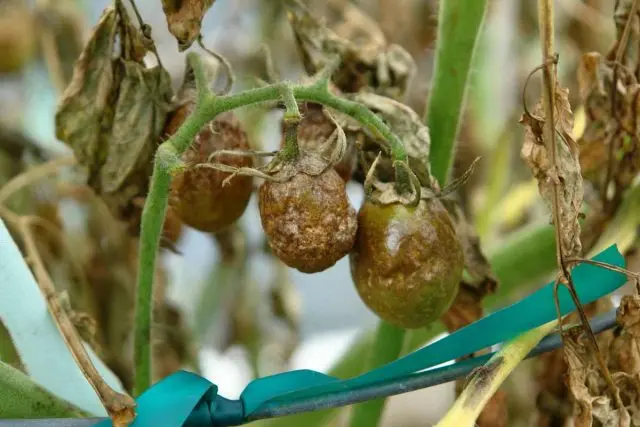
Advantages and disadvantages of the variety
Studying the strengths and weaknesses of the Golden Rain tomato allows you to determine the need for its cultivation in the garden.
The most valuable qualities of a variety of tomatoes:
- decorative appearance of the fruit (elongated, yellow, small size);
- versatility of use, preservation of presentation during transportation over long distances;
- the possibility of mechanization of harvesting due to the easy separation of the tomato from the stem;
- high yield;
- resistance to a certain group of diseases.
The disadvantages of the variety include the need for timely pinching and the formation of a bush. It is important for the plant to provide proper care in order to get the maximum amount of yield.
Rules for planting and caring for Golden Rain tomatoes
The choice of the method of cultivating a variety depends on the weather conditions and the capabilities of the gardener. In regions with a cold and humid climate, it is preferable to grow tomatoes in greenhouse conditions. Under favorable conditions, a good harvest can also be harvested from bushes growing in open ground.
The optimal time for planting tomato seeds Golden rain for seedlings is the beginning of March. Young plants are transferred to open ground at a temperature not lower than + 10 ° C.
Planting seeds for seedlings
The first stage of growing the Golden Rain tomato variety is the preparation of seed and containers.
For seedlings, soil rich in organic elements is selected, therefore it is preferable to use a mixture of manure, earth and compost from the garden, peat. It is also possible to use specialized soil, which can be purchased at gardening stores.
Sowing seedlings is carried out 60-75 days before transfer to open ground, when cultivated in greenhouse conditions, the procedure is carried out earlier.
It is recommended to place the seed in peat pots or plastic cups so as not to injure the root system during planting in the garden.
Both the soil and the seeds of tomatoes are disinfected without fail. The earth is calcined in an oven or spilled with a solution of potassium permanganate. Seeds are treated with disinfectants and growth stimulants.
Care of seedlings consists in its timely watering and control of lighting. Seedlings need to provide a warm, accessible place for sunlight, where drafts do not penetrate. To speed up the germination of seeds, containers are covered with glass or film.
With a lack of lighting, lamps are used, which are left on for 18 hours a day.
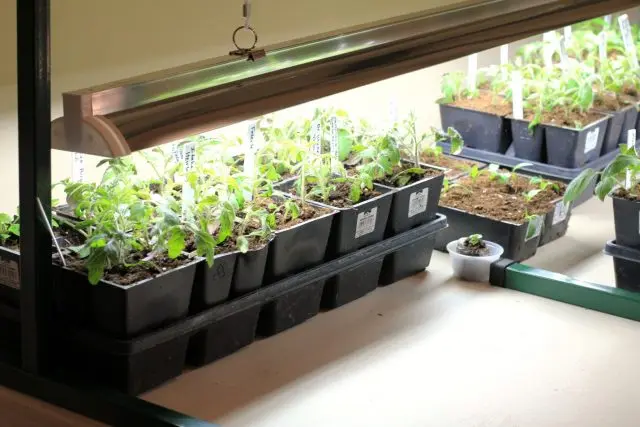
Transplanting seedlings in open ground
7-10 days before transplanting into the garden, Golden Rain tomatoes must be hardened. To do this, the containers with the plant are taken out into the street, gradually increasing the time they spend in open sunlight.
A bed is formed so that the variety is placed at a distance of 60 cm from each other while maintaining a distance between rows of 70 cm.
The earth is dug up and holes are formed, fertilizer is laid in them and well spilled. The seedling of the variety is transferred to the ground, sprinkled with earth on top.
At the end of the procedure, the Golden Rain variety must be mulched with non-woven fiber or straw. This allows you to retain moisture in the soil and prevent the active growth of weeds.
Aftercare
Watering the Golden Rain tomato variety must be done under the root so that water does not fall on the leaf plates and stem. The frequency of the procedure depends on the climate: it is necessary to prevent waterlogging or drying out of the earth. Greenhouses need to be ventilated regularly.
Top dressing is carried out with preparations containing phosphorus, nitrogen and potassium. When choosing a specific tool, it is used according to the manufacturer’s instructions.
To prevent the stems from bending to the ground under the weight of the fruit, the Golden Rain variety needs a garter. It is possible to build a trellis, use metal or wooden stakes.
Necessarily timely formation of the bush. You can leave up to 4 stems, but fewer are allowed.
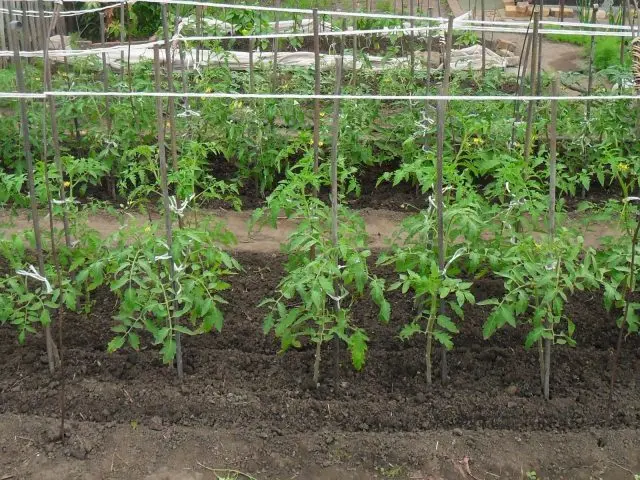
For the prevention of diseases, Bordeaux liquid is treated, all affected leaf plates are removed, and the condition of the plant is carefully monitored. It is important to regularly loosen the soil, inspect the variety for damage.
When signs of a black leg appear, the damaged seedling is immediately removed, the soil is disinfected and loosened, and watering is reduced. The stems and leaf plates of the Golden Rain tomato must be irrigated with biological fungicides: Fitolavin, Trichodermin. It is recommended to re-treat after 10 days.
For the treatment of late blight, it is possible to use drugs such as Fitosporin, Homo.
Conclusion
Golden rain tomato is preferred to be grown in southern countries: the plant is drought resistant. In medium climatic zones, high yields can be achieved by growing tomato varieties in greenhouse conditions. The fruits of the Golden Rain tomato have not only high taste, but also a decorative appearance.









